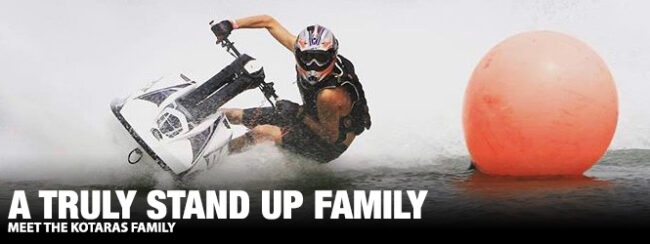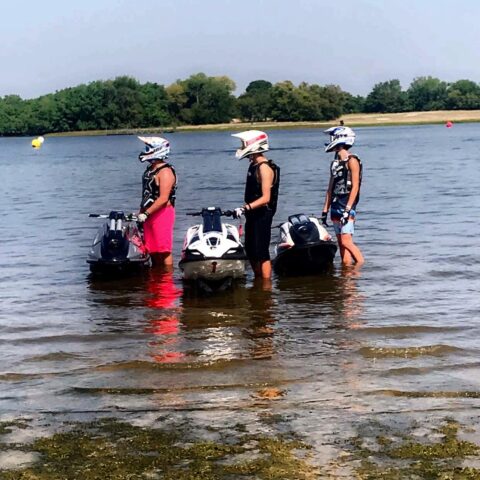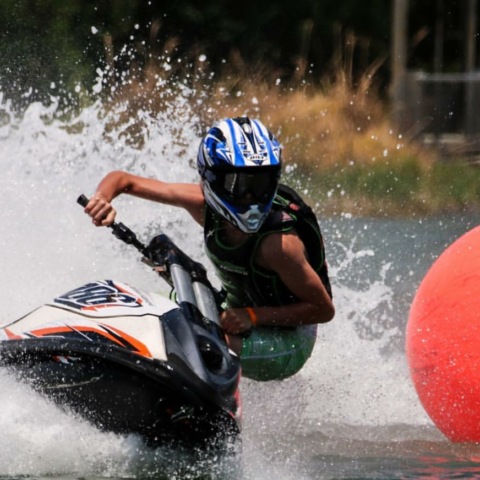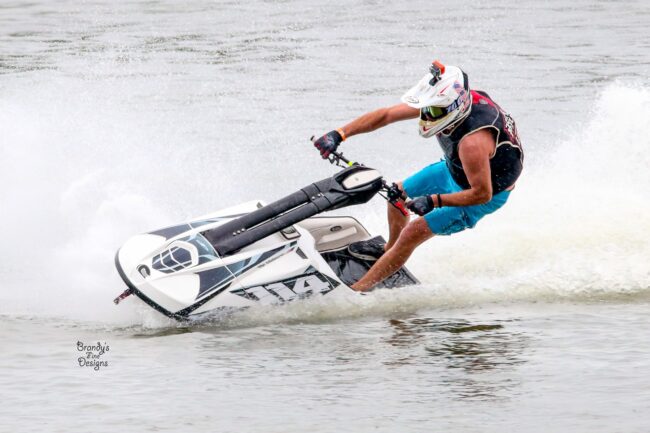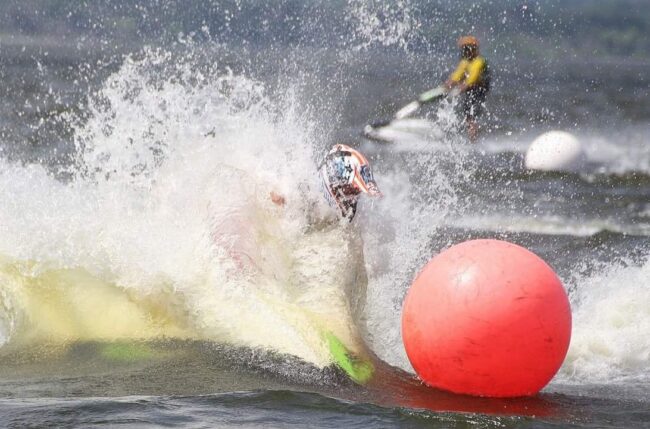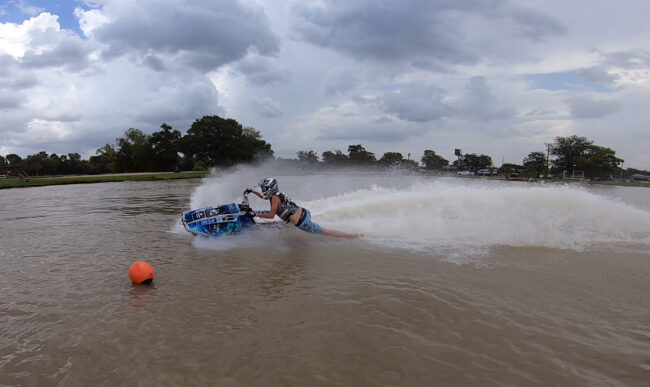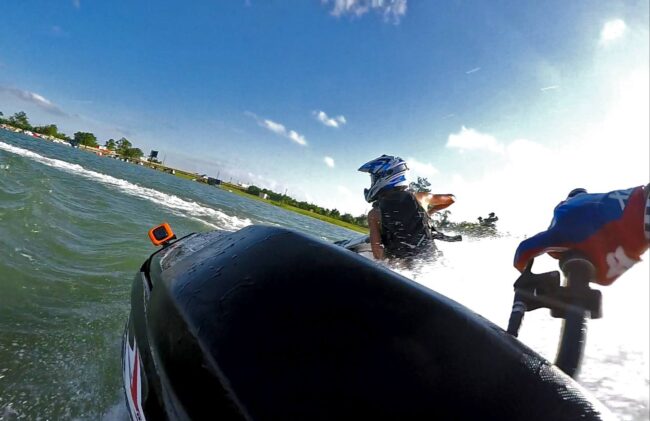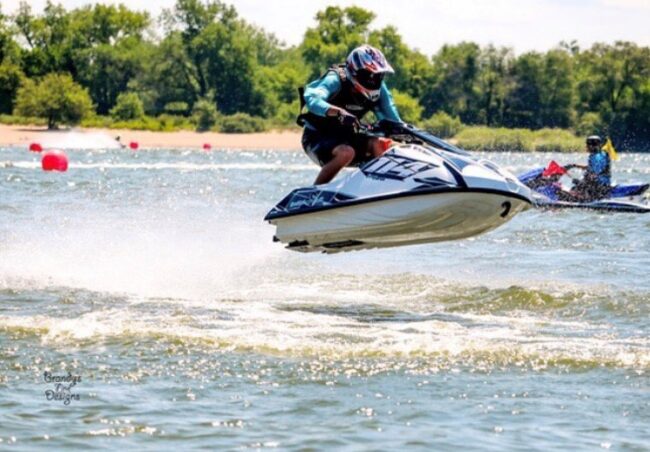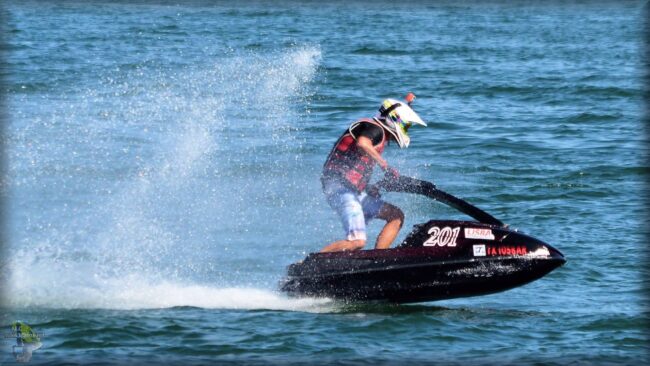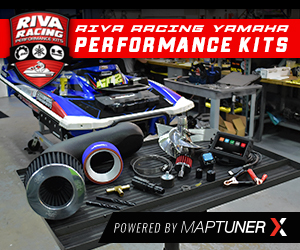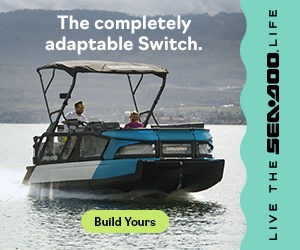We met the Kotara family at my first Texas race in 2016 and was truly inspired by their positive attitude and entire family’s immersion in the sport of riding stand up jet skis. William, his wife Tracy, and his three sons, Ty, Mason, and Tanner, always had a smile on their face while racing and helping fellow racers. It was incredibly inspiring to see a tight-knit family held together by the strong bond of fellowship and motorsport.
Fast forward three years, and quite a few more races together, we had the chance to get each of their unique perspectives about the stand up jet ski community.
The Watercraft Journal: We’re excited to have you all on The Watercraft Journal! Let’s start at the beginning – when did you first start riding stand ups, what made you want to try, and how difficult was it to stand at first?
William: I bought my first one new. A 1993 Kawasaki 750sx which wasn’t too bad going straight, but I never figured out how to turn it. No one told me I had to drag a body part. But my first PWC was a 1985 wet bike, which I still have.
Ty: I was about 12-years-old when I first started riding. I learned on a Kawasaki 550 and it took me a while to be able to stand up. I used to ride back and forth on my knees until I felt confident enough to start standing.
Mason: I first started to ride stand ups around the age of 9, but even before then I would go on rides with my dad, who is the person who gave me the interest in riding them. Standing was definitely a huge learning curve from putting around on my knees, but with persistence it was not too hard to get the hang of.
Tanner: Jet skis have always been a part of my family’s life and they were usually around at every vacation. That being said, it wasn’t long before I tried to ride one for myself. The feeling came naturally and I felt like a professional in seconds. The rush of energy while riding is absolutely absurd.
WCJ: William, how did you involve your sons in your love of motorsports and PWC?
William: They were naturally drawn. I had already exposed them to dirt bikes and when they saw me racing they naturally wanted to also. I felt it was much safer than motocross also. We’ve have our share of dirt bike crashes.
WCJ: Once you learned to ride, why did you choose racing stand ups, and when?
William: A friend got me to race a Texas Super Course Endurance race and I was hooked. Shortly after I bought a 2007 Kawasaki SX-R limited.
Ty: I started racing in 2008 and I choose stand ups because that is all we had at the time. A few years later my dad bought us a Sea-Doo HX and we raced that for a couple of seasons, then decided to sell it to buy to another stand up so we could all race in the same class.
Mason: My thoughts about stand ups were always about racing, once again because of my dad who introduced me to the racing scene at a very young age. He was always dragging me and my two brothers along to his endurance races he and his friends would compete in. As soon as I turned 10-years-old (the required age to being racing) I started to race alongside my older brother Ty in the Junior classes (2010).
Tanner: Racing stand ups allows for more of a skill gap than sit downs. You don’t need the fastest ski to beat someone (but it certainly helps). Being the youngest child, it was a no brainer that I wanted to start racing as soon as I became of age. Sitting on the shore (not of age to race) watching my brothers battle it out on the track was a kick in the gut. I couldn’t wait until the day I turned 10 and be able to join them on the starting line.
WCJ: With racing for nearly or over a decade, what are your greatest accomplishments while racing stand ups?
William: Definitely second place in Ski Limited in Region 5. One of my favorite seasons. Also several wins on the ProForce, but can’t remember my overall anymore.
Ty: My best accomplishment was taking sixth place in Amateur Ski Open at the IJSBA World Finals.
Mason: My accomplishments in stand up racing include many regional championships in multiple junior classes as well as being able to win a few races on the National Tour as a junior.
Tanner: Racing definitely came with many first place finishes, but the most memorable accomplishments are within the jet ski community that accepted me into the racing world. The friends that repetitively came to every race soon became some sort of second family to me. These accomplishments are, without a doubt, on a higher level than the psychical trophies you receive at the end of a season.
WCJ: What is your favorite ski?
William: The Pro Watercraft Racing ProForce. The low tray and handling works well for me being 6’4”. I can ride that ski faster than anything else I have been on.
Ty: My favorite ski is definitely the ProForce.
Mason: A favorite ski is a hard thing to pick because every ski has something unique about it, but my all-time favorite ski for both racing as well as leisurely riding would have to be the Kawasaki SX-R 800. The handling of this ski and how it allows you to really lay it over in the turns really gives a new rider a great foundation to build their riding skills off of, while at the same time being a great ski to go cruise on the lake.
Tanner: There are many different skis someone can choose from when purchasing a stand up. All my life I have rode and raced a stock Kawasaki SX-R 800. Although that doesn’t mean it is my favorite ski. From an affordable standpoint, my favorite ski is the Yamaha SuperJet. On this ski, you can easily control it as the haul of the ski works with you at all times. Whether you’re cruising in a straight line, or taking a sharp turn, the ski always maneuvers in the best way to help the situation.
WCJ: Continuing with the favorites, what is your favorite thing about the racing community?
William: Great friends. People that will lend you parts motors whatever just so you can run that weekend. I have made some great friends over the years from all over, all because of racing.
Ty: The racing community is always really nice to everyone and always willing to help out. I’ve had friends let me borrow parts before a race just so I could line up next to them.
Mason: The racing community is full of great wholehearted people. The jet ski racing community is incomparable to anything but one giant family. Everyone involved will go out of their way to help you with anything you need no matter what, while also being your biggest competitors on the course. My favorite thing by far has to be the people in the community because they are all basically just one giant family.
Tanner: The racing community is very accepting and eager to get to know the rookies. It’s very hard to have a frowning face at the races. Even if your engine just blew up, there is always that one guy who will make a joke about it and in my opinion, that’s the best part of the community.
WCJ: Well said! The watercraft racing community is definitely tight-knit and that is the integral part that keeps us all coming back for more. When racing, what is your current ride and in what classes?
William: Haha, well, due to a lot of mechanical issues lately whatever ski is running. I’ve tried racing a few different classes for fun like X2, etc. My favorite class is GP. Next year I plan to be all in on a new ProForce 2.0.
Ty: I race the ProForce and my classes are Pro Ski Open. At IJSBA World Finals I race Expert Ski Open and Amateur Ski Open.
Mason: Currently I ride a Hydro-Doo; a Hydrospace S4 hull with a Sea-Doo 951 swapped into it. I race Amateur or Pro Ski GP as well as pro ski stock and occasionally vintage X2.
Tanner: I currently race Stock class on my classic Kawasaki SX-R 800 and Vintage class with a Kawasaki X2.
WCJ: Looking towards to future, what are your riding goals?
William: Next year I hope to ride more and wrench less.
Ty: Just to keep riding and racing, and hope to get a title soon at World Finals.
Mason: My goals for my future riding would have to be to race in World Finals, because after almost a decade of racing I have still yet to make that race.
Tanner: While riding, there is always room for improvement and I strive to learn and master those skills. Any racer’s goal is to be the best, but that doesn’t come easy. You need to be original and adaptable. The same techniques are going to get outdated and replaced with more efficient riding styles.
WCJ: Riding stand up jet skis takes skill so how do you train/practice to keep on top of your game?
William: I’ve tried lots of things and anything that helps your endurance is good, but riding a lot is the best for me.
Ty: I work out once every day by doing cardio and lifting weights. I also try to diet as best as I can and ride when I get to the chance to.
Mason: There is no better way to get in shape for jet ski racing than to just go out and ride. My family and I are extremely blessed to have land in Gillett, TX where we have a “private lake” in a sense. This pond/lake is moderately close to our house which makes it very easy for my brothers and I to go out and practice almost any time we’d like. We also ride a lot at Lake LBJ where the water is a lot choppier to really get that “race feel”.
Tanner: The best way to train is with, what I like to call, a “Mini Race.” That is when you set up a track and go ride with a group of friends until you can’t hold on anymore and eventually, doing it again. That will develop and mature the muscles needed for a full race.
WCJ: With all of your racing experience is there anything you would like to see done differently in the racing world?
William: Consistent rules throughout the racing community.
Ty: I would like to see jet ski racing receive support like Supercross.
Mason: I would like to see the jet ski racing world really take off and grow to the size of Supercross or even bigger. I think it is an awesome hobby/sport that not many people know about, but many would support if they did.
Tanner: In the racing world, we need a more attractive way to market racing. Bringing in new racers is crucial to keeping the community alive.
WCJ: I could not have said it any better, sharing stand ups with the world is the only way to help grow this amazing sport! It could really change a lot of lives in a positive way, just needs more exposure. Curious to hear how today’s racing scene different from years ago?
William: I think most today race for fun and enjoy spending time with those with the same interest. It is more of a family sport for me. The Vintage classes have gotten more popular due to the low cost and even competition.
WCJ: Interested to hear who each of your greatest role models are?
William: My dad for his work ethics, Faith, and support. In the racing scene – all the guys in Masters that are way older than me and can still smoke me. It gives me the drive to keep going.
Ty: That would be my dad, always working on all of our skis, getting everything loaded up for the races, then driving to different states for us to line up.
Mason: My greatest role model is my dad. He has taught me almost everything there is to know about jet skis from riding to building them. He is the one who has given me the opportunity to race and ride, and I look up to him in every way possible.
Tanner: My greatest jet ski role model would easily be my dad, William Kotara. His knowledge of engines and ability to locate and fix a problem with swiftness is unlike anyone else. At least one time per race weekend, I see this cycle follow through, and it blows my mind. Just when I think my weekend is cut short, he is out on the water testing the ski and making sure the fix is viable.
WCJ: Outside of skis, what other things do you like to do?
William: Fishing and raising cattle.
Ty: When I’m not racing I’m either at school or riding my dirt bike.
Mason: Currently I am attending Blinn College in Bryan, Texas and hope to transfer into Texas A&M soon, but other hobbies outside of riding skis mainly consist of video games or anything involving a computer, and biking/running.
Tanner: During the off-season, my hobbies consist of maintaining a family farm, riding dirt bikes and four wheelers, and running hurdles in track. None of these compare to the joy that jet skis bring, but weather doesn’t allow for all year riding.
WCJ: Thank you guys so much for taking the time to share your family’s PWC story with us. It has been quite enjoyable to hear each of your unique goals, advice, and history. I’d like to end with a final question and that is what advice would you give to fellow racers and people interested in learning how to ride stand ups?
William: For beginners learn to ride with either foot forward. Switching feet is needed for carving turns. That’s the most common problem I see. Don’t be scared to come to a race. The jet ski community is one of the most welcoming groups of people I have seen.
Ty: To buy a stock ski and learn the basics before going out and buying a ski out of their means.
Mason: Stand up jet skis are a great hobby, whether you are racing or just riding. It may be frustrating to learn how to do it at first, but once you get the hang of it you’ll never look back.
Tanner: Riding stand ups is a feeling and skill set that is not easily described, but best learned from experience. There are tips and tricks that fellow riders may share with you, but it’s best to learn those for yourself through the joy of riding a jet ski.





